Choosing between the Autel Nano Plus Vs Dji Mini 3 Pro for your next ultra-light drone can be tough. CARDIAGTECH.NET helps you decide with an in-depth comparison, focusing on performance, camera quality, and features to make the right choice. Consider factors like collision avoidance, battery life, and video capabilities to ensure you select the drone that best fits your needs. Discover which drone offers superior maneuverability and image processing for professional results.
1. Design and Build Quality: A Detailed Comparison
When you’re looking at ultra-light drones, design and build quality are critical. Both the Autel EVO Nano Plus and the DJI Mini 3 Pro are designed to be compact and lightweight, making them ideal for pilots who need portability. The design philosophies, however, differ significantly. Let’s dive into the specifics.
| Feature | DJI Mini 3 Pro | Autel EVO Nano Plus |
|---|---|---|
| Take-Off Weight | 249g | 249g |
| Size (Unfolded) | 171 x 245 x 62mm | 170 x 215 x 55mm |
| Size (Folded) | 145 x 90 x 62mm | 142 x 94 x 55mm |
| Diagonal Span | 247mm | 253mm |
| Collision Sensors | Front / Back / Down | Front / Back / Down |
| Color Options | Standard grey | Orange, Grey+Yellow, Light Grey+Graphite, Pure Red |
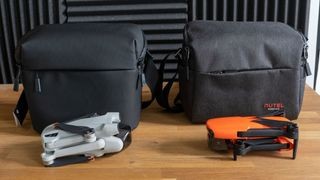
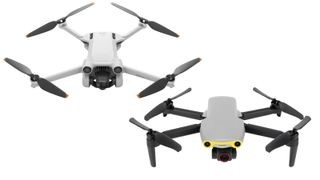
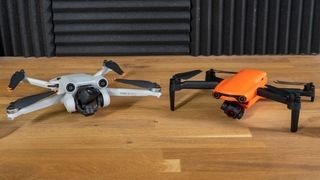
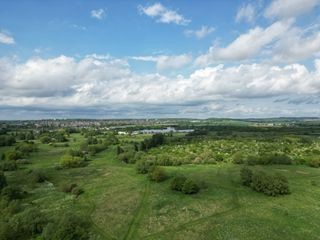
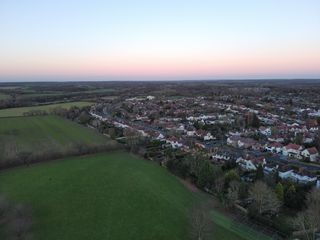
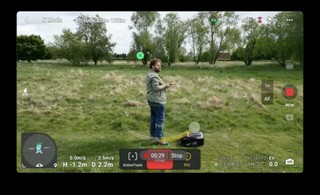
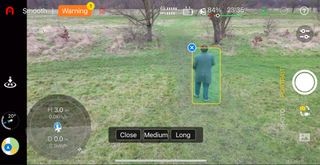
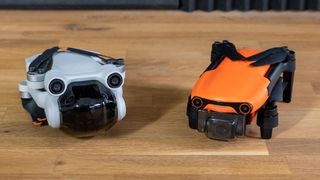
The DJI Mini 3 Pro adopts a streamlined aesthetic, reminiscent of a compressed version of the Air 2S. Its landing gear consists of small nubs integrated into the fuselage, giving it a sleek, modern appearance.
The Autel EVO Nano Plus, on the other hand, features a more utilitarian design. The front arms extend to provide landing legs, similar to the DJI Mini 2, which enhances stability during takeoff and landing on uneven surfaces.
One notable advantage of the Autel EVO Nano Plus is the inclusion of a propeller strap and gimbal cover, offering added protection during transport. DJI only includes a gimbal cover, which some users find cumbersome. Additionally, Autel’s batteries feature a 4-LED test circuit, allowing you to check battery levels even when the batteries are not installed in the drone, a feature absent in the DJI Mini series.
2. Speed and Maneuverability: How Do They Compare?
Speed and maneuverability are essential factors to consider when choosing a drone, especially if you plan to capture dynamic footage or navigate challenging environments. Both the DJI Mini 3 Pro and the Autel EVO Nano Plus offer impressive performance for their size, but there are subtle differences.
| Feature | DJI Mini 3 Pro | Autel EVO Nano Plus |
|---|---|---|
| Maximum Speed | 36mph | 33.5mph |
| Wind Resistance | Level 5 Beaufort | Level 5 Beaufort |
| Speed Modes | Cine, Normal, Sport | Smooth, Standard, Ludicrous |
Both drones are rated to withstand Level 5 winds on the Beaufort scale, also known as a “Fresh Breeze,” suggesting they can handle moderately windy conditions. However, in practical tests, the DJI Mini 3 Pro often feels more stable in the air, while the Autel EVO Nano Plus may exhibit more noticeable dancing or wobbling, potentially affecting your confidence in gusty conditions.
Both drones offer multiple speed modes to cater to different flying scenarios. DJI uses Cine, Normal, and Sport modes, while Autel uses Smooth, Standard, and Ludicrous. Regardless of the branding, the lower settings are ideal for capturing smooth, cinematic footage, while the highest settings unlock the drone’s full speed potential.
3. Battery Life and Flight Time: What to Expect
Battery life is a crucial consideration for any drone pilot. Knowing how long you can keep your drone in the air directly impacts your ability to capture the shots you need. Here’s a detailed look at how the DJI Mini 3 Pro and Autel EVO Nano Plus compare in terms of battery performance.
| Feature | DJI Mini 3 Pro | Mini 3 Pro Flight Battery Plus | Autel EVO Nano+ |
|---|---|---|---|
| Theoretical Max Flight Time | 34 mins | 47 mins | 28 mins |
| Hover Time | 30 mins | 40 mins | 28 mins |
| Battery Capacity | 2453mAh | 3850mAh | 2250mAh |
| Battery Weight | 80.5g | 121g | 83g |
As the table illustrates, the DJI Mini 3 Pro has a theoretical maximum flight time of 34 minutes with the standard battery. The optional Intelligent Battery Plus extends this to an impressive 47 minutes. The Autel EVO Nano+ lags, with a maximum flight time of 28 minutes.
Real-world flight times are typically lower than the theoretical maximum due to factors like wind, aggressive flying, and the time needed for return-to-home functions. With the standard battery, you can expect around 24 minutes of useful flight time from both drones in good weather conditions.
4. Gimbal and Camera: Image Quality and Stability
The gimbal and camera system are at the heart of any drone designed for aerial photography and videography. They determine the quality of your images and videos and how stable your footage will be, even in challenging conditions. Let’s examine how the DJI Mini 3 Pro and Autel EVO Nano Plus stack up in this crucial area.
| Feature | DJI Mini 3 Pro | Autel EVO Nano Plus |
|---|---|---|
| Axis | 3 (pitch, roll, yaw) | 3 (pitch, roll, yaw) |
| Tilt | -135˚ to 80˚ | -125˚ to 35˚ |
| Roll | -135˚ to 45˚ | -33˚ to 34˚ |
| Pan | -30˚ to 30˚ | -25˚ to 25˚ |
Both drones feature a 3-axis gimbal, which stabilizes the camera along the pitch, roll, and yaw axes. However, the DJI Mini 3 Pro has a unique trick: it can rotate the camera 90˚ to portrait mode.
DJI’s gimbal has more range of motion, offering greater ability to compensate for pitch and roll. Aggressive flying may push the EVO Nano’s gimbal to its limits more easily.
5. Controller and Range: Connectivity and Control
The controller and range capabilities of a drone are essential for a seamless and reliable flying experience. The controller is your primary interface with the drone, and its ergonomics and features can significantly impact your control and comfort. The range determines how far you can fly the drone while maintaining a stable connection, ensuring you can capture those distant shots without worrying about signal loss.
| Feature | DJI Mini 3 Pro | Autel EVO Nano Plus |
|---|---|---|
| Technology | DJI O3 | Autel Skylink |
| Range – FCC (USA) | 12km | 10km |
| Range – CE (UK, EU) | 6km | 6km |
| Live View Quality | 1080p/30fps | 2.7k/30fps |
When it comes to communication technology, both drones offer impressive range. In the USA, the DJI Mini 3 Pro boasts a range of 12km, while the Autel EVO Nano Plus offers 10km. In regions like the UK and EU, where regulations limit the range, both drones are capped at 6km.
6. Still Photos: Capturing High-Quality Images
The ability to capture high-quality still photos is a key consideration for many drone enthusiasts. Whether you’re a professional photographer or an amateur hobbyist, the camera’s performance directly impacts the quality of your aerial images. Here’s how the DJI Mini 3 Pro and Autel EVO Nano Plus compare in terms of still photo capabilities.
| Feature | DJI Mini 3 Pro | Autel EVO Nano Plus |
|---|---|---|
| Resolution | 48 MP | 50 MP |
| Sensor Size | 1 / 1.3 inch | 1/1.28 inch |
| ISO Range | 100-6400 | 100-6400 |
| Field of View (FOV) | 82.1˚ | 85˚ |
| Max Aperture | ƒ/1.7 | ƒ/1.9 |
| Formats | JPEG / DNG (RAW) | JPEG / DNG (RAW) |
With similar sensor sizes and megapixel counts, both drones are capable of capturing impressive images. The Mini 3 Pro has an edge with its wider aperture.
The DJI’s processing lets more unprocessed information through, resulting in softer edges and more noise.
The Autel EVO Nano Plus applies stronger sharpening to edges, with less saturation.
7. Video Capabilities: Resolution, Frame Rates, and More
Video capabilities are crucial for drone users who want to capture smooth, high-quality aerial footage. Whether you’re shooting cinematic landscapes, action sequences, or professional videos, the drone’s video performance is a key factor in achieving the desired results. Here’s a detailed comparison of the video features offered by the DJI Mini 3 Pro and Autel EVO Nano Plus.
| Feature | DJI Mini 3 Pro | Autel EVO Nano+ |
|---|---|---|
| Resolution | 4K/60fps | 4K/30fps |
| Slow Motion | 1080P/120fps | – |
| Bitrate | 150mbps | 100 Mbps |
| Digital Zoom at 4K | 2x | 2x |
| Digital Zoom at 1080P | 4x | 16x |
The DJI Mini 3 Pro edges out the Autel EVO Nano+ with its 4K/60fps recording capability. However, shooting at 4K60fps on the DJI Mini 3 Pro means you lose the HDR effect of the drone’s dual-native ISO.
8. Software Features: Intelligent Flight Modes and Tracking
Software features play a significant role in enhancing the user experience and expanding the creative possibilities of a drone. Intelligent flight modes, AI subject tracking, and other automated functions can simplify complex maneuvers and help you capture professional-looking footage with ease. Let’s explore the software features offered by the DJI Mini 3 Pro and Autel EVO Nano Plus.
More exciting for many is AI subject tracking, in which the drone plots its own path to keep the subject in camera, while avoiding obstacles.
The Mini 3 Pro can track a subject as a POI and orbit the subject at the same time.
The Autel Nano Plus Portrait function offers use of the tracking feature to follow a moving subject, turning the drone as needed.
9. Pros and Cons: Quick Overview
To help you make a decision, here’s a quick summary of the pros and cons of each drone.
DJI Mini 3 Pro Pros:
- Superior video quality with 4K/60fps
- More reliable airframe, especially in windy conditions
- Wider gimbal movement
- More advanced software features
- Choice of controllers
DJI Mini 3 Pro Cons:
- May require more image processing
Autel EVO Nano+ Pros:
- Excellent image quality
- Built-in battery testers
- More color options
- Narrate Feature
Autel EVO Nano+ Cons:
- Shorter battery life
- Less stable in windy conditions
- Less advanced software features
10. Making Your Choice: Which Drone Is Right for You?
Choosing between the DJI Mini 3 Pro and the Autel EVO Nano Plus depends on your specific needs and priorities.
If you value superior video quality, a more reliable airframe, and advanced software features, the DJI Mini 3 Pro is the better choice. Its 4K/60fps video capability, wider gimbal movement, and intelligent flight modes make it a versatile tool for both amateur and professional use.
If you prioritize excellent image quality, longer battery life, and a more comfortable controller, the Autel EVO Nano Plus is a strong contender. Its built-in battery testers and multiple color options add to its appeal.
FAQ: Answering Your Questions
Q1: What is the primary difference between the DJI Mini 3 Pro and the Autel EVO Nano Plus?
The DJI Mini 3 Pro offers superior video capabilities with 4K/60fps, a more reliable airframe, and advanced software features. The Autel EVO Nano Plus excels in still image quality and offers a more comfortable controller.
Q2: Which drone has better obstacle avoidance?
Both drones have front, back, and down collision sensors.
Q3: Can both drones shoot in RAW format?
Yes, both the DJI Mini 3 Pro and Autel EVO Nano Plus can shoot in JPEG and DNG (RAW) formats.
Q4: Which drone is better for windy conditions?
The DJI Mini 3 Pro is generally considered more stable and reliable in windy conditions.
Q5: Does the DJI Mini 3 Pro offer vertical shooting?
Yes, the DJI Mini 3 Pro can rotate its camera 90 degrees for vertical shooting, a feature not available on the Autel EVO Nano Plus.
Q6: Which drone has a longer flight time?
The DJI Mini 3 Pro has a longer theoretical maximum flight time of 34 minutes compared to the Autel EVO Nano Plus’s 28 minutes.
Q7: What is the maximum transmission range of both drones?
The DJI Mini 3 Pro has a range of 12km (FCC) and 6km (CE), while the Autel EVO Nano Plus has a range of 10km (FCC) and 6km (CE).
Q8: Which drone is easier to fly for beginners?
Both drones are relatively easy to fly, but the DJI Mini 3 Pro’s more stable performance and advanced software features may make it slightly more accessible for beginners.
Q9: Which drone has better image processing?
The DJI Mini 3 Pro tends to let more unprocessed information through, requiring more post-processing. The Autel EVO Nano Plus applies stronger sharpening and noise reduction, which may look better straight out of the camera but offer less flexibility for editing.
Q10: Where can I buy high-quality drone accessories?
You can find a wide range of drone accessories at CARDIAGTECH.NET.
Are you facing challenges in keeping up with the latest automotive technology and finding the right tools to enhance your repair efficiency? At CARDIAGTECH.NET, we understand these hurdles. That’s why we offer a comprehensive range of cutting-edge diagnostic tools and equipment designed to boost your productivity and precision. Contact us today at 276 Reock St, City of Orange, NJ 07050, United States or WhatsApp us at +1 (641) 206-8880 for expert advice and solutions tailored to your needs. Let CARDIAGTECH.NET be your partner in achieving excellence in automotive repair.
